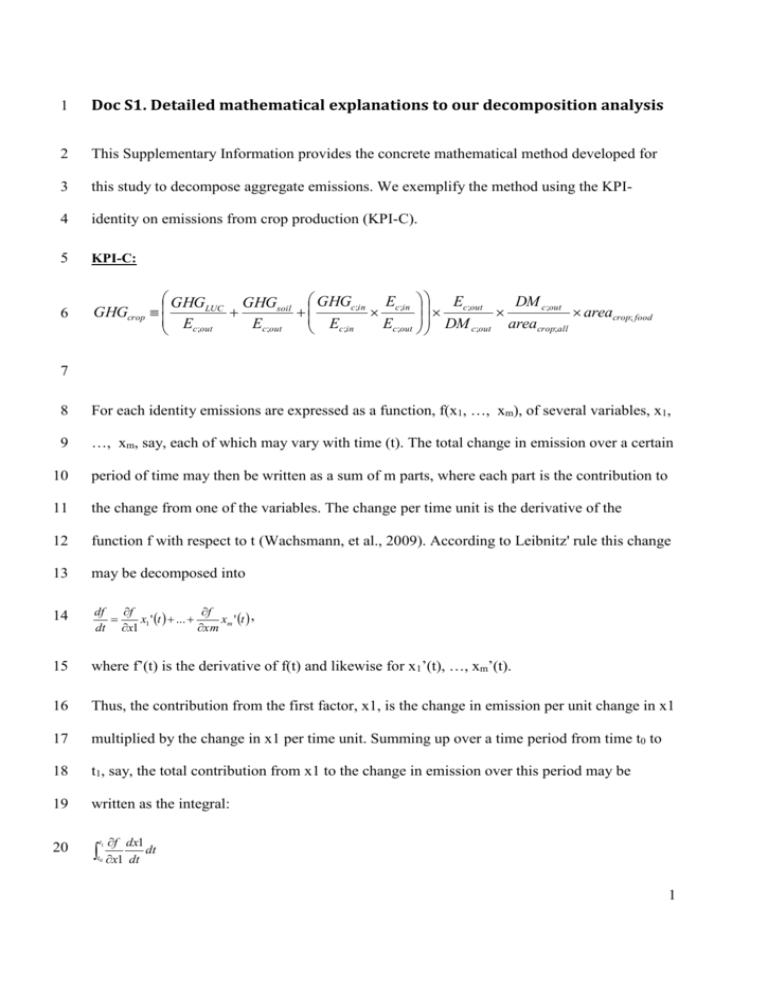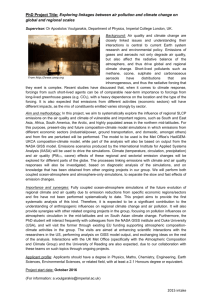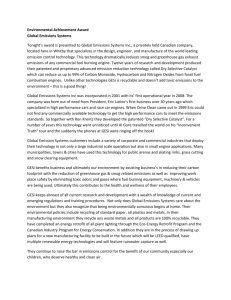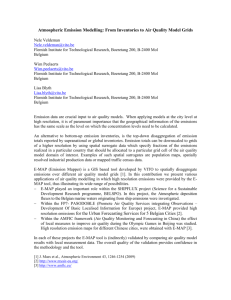gcb13120-sup-0001-Supinfo
advertisement

1 Doc S1. Detailed mathematical explanations to our decomposition analysis 2 This Supplementary Information provides the concrete mathematical method developed for 3 this study to decompose aggregate emissions. We exemplify the method using the KPI- 4 identity on emissions from crop production (KPI-C). 5 KPI-C: 6 GHGLUC GHGsoil GHGc;in Ec;in Ec;out DM c;out GHGcrop areacrop; food Ec;out Ec;out Ec;out DM c;out areacrop;all Ec;in 7 8 For each identity emissions are expressed as a function, f(x1, …, xm), of several variables, x1, 9 …, xm, say, each of which may vary with time (t). The total change in emission over a certain 10 period of time may then be written as a sum of m parts, where each part is the contribution to 11 the change from one of the variables. The change per time unit is the derivative of the 12 function f with respect to t (Wachsmann, et al., 2009). According to Leibnitz' rule this change 13 may be decomposed into 14 df f f x1 ' t ... xm ' t , dt x1 xm 15 where f’(t) is the derivative of f(t) and likewise for x1’(t), …, xm’(t). 16 Thus, the contribution from the first factor, x1, is the change in emission per unit change in x1 17 multiplied by the change in x1 per time unit. Summing up over a time period from time t0 to 18 t1, say, the total contribution from x1 to the change in emission over this period may be 19 written as the integral: 20 t1 t0 f dx1 dt x1 dt 1 21 In the KPI-C the emissions from crop production are a sum of three terms, each of which is a 22 product of a number of factors. The second term, for example, may be written y=x1·x2·x3·x4, 23 where x1=GHGsoil/Ec;out, x2= Ec;out/DMc;out, x3=DMc;out/areacrop;all and x4= areacrop;food. The 24 contribution from x1 to the change from t0 to t1 may be written as (Wachsmann, et al., 2009): 25 y t1 , ln y ln y yt0 ln x1t1 ln x1t0 t1 t0 26 which is based on an interpolation of x1t by an exponential function from time t0 to time t1. 27 Exponential interpolation is possible only for variables with positive values, but the first term 28 in KPI-C has a factor, x1=GHGLUC/Ec;out, which may take negative values. For such a variable 29 we use linear interpolation and obtain its contribution, Cx1, to the change as 30 C x1 31 when the other three variables are positive, and we have used the notation r2=ln(x2t1)-ln(x2t0) 32 for the logarithmic change in x2 and similarly for x3 and x4. In this case the contribution from 33 x2 is given by: 34 Cx2 35 with similar expressions for Cx3 and Cx4. 36 Finally, all contributions from each specific variable are added to obtain the contribution from 37 that variable to the total change. 38 References 39 Wachsmann, U., Wood, R., Lenzen, M. & Schaeffer, R. (2009): Structural decomposition of 40 energy use in Brazil from 1970 to 1996. Applied Energy. Vol. 86:4, pp. 578-587. x1 t1 y t1 x0 t0 x 2 t1 x3t1 x 4 t1 x 2 t x3t0 x 4 t0 r 2 r 3 r 4 yt0 C x1 r 2 (r 2 r 3 r 4) 0 , , 2











